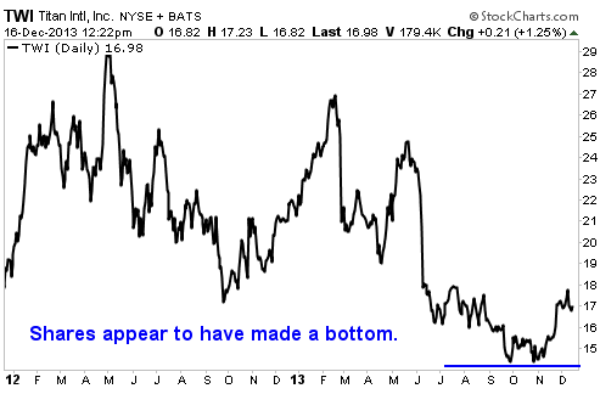While most companies will have plenty to cheer these holidays, as their stock prices soared in 2013, some companies would just as soon turn the page and focus on the new year.
Companies operating in the mining industry certainly fall into the latter category. This sector hasn't suffered such tough times in several years. The sharp drop in commodity prices led to the rapid slump in demand for all kinds of mining equipment.
Mining is a highly cyclical business, and though investors have been shunning mining stocks in 2013, signs of stabilization should boost them in 2014, especially as the outlook for better days ahead comes into focus.
And when that happens, investors will focus on the companies with a great deal of leverage. It helps if these companies have a wide moat around their business, i.e., a significant competitive advantage that is extremely difficult to copy or emulate, thereby creating a barrier to entry for competing firms. This implies that they will have full pricing power when business conditions improve.
Titan International (NYSE: TWI) fits this bill. The company makes huge truck tires used by massive mining trucks, agricultural equipment and other off-road mega-vehicles. TWI will never enjoy the benefits of the huge market for cars and small trucks, but its niche yields large prices and impressive profit margins. For example, TWI generated 9.6% operating margins in 2012, while Goodyear Tire (NASDAQ: GT) has not exceeded 3% operating margins in the past decade.
But for investors, 2012 is a long time ago. In 2013, TWI was hit with a double whammy. Not only has demand slowed for big tires, but key customers overbought last winter and ended up unloading many nearly new tires onto the market. And that has led organic revenue growth to falter. (A few acquisitions in 2012 and 2013 are enabling TWI to still post modest top-line gains.)
More importantly, profits are getting crushed. TWI has missed profit forecasts by at least 40% in three of past four quarters, and per-share profits are on track to fall by nearly half this year, to $0.94 a share
The process of clearing the glut of tires from the market is hurting results now, but should help stabilize results in 2014. Analysts currently expect sales to grow around 5% in 2014 to around $2.3 billion, and per-share profits to rise roughly 19% to $1.09.
But management thinks that analysts, having been burned on several occasions this year, have become too conservative. In late November, TWI issued a press release predicting 2014 sales of at least $2.4 billion, and perhaps as high as $2.7 billion. And that assumes no new acquisitions.
Revenues are expected to get a boost from a newly lunched tire reclamation division. Breaking down used tires yields oil, steel and carbon black, all of which have value in the after-market. Management thinks this division will generate solid profit margins.
The projected 2014 revenue base should translate into EBITDA of $240 million to $270 million. That compares to $102 million in operating income in the first nine months of 2013, or around $135 million on an operating basis.
Management's 2014 guidance is based on still-challenging business conditions in 2014. Yet in coming quarters, investors will start to look ahead, and assuming a return to normal business conditions in 2015 and 2016, then there's no reason TWI can't earn $2 to $2.50 a share. For context, the company earned nearly $2 a share in 2012, and its customer base is now larger thanks to a recent acquisition in Russia and the just-launched tire reclamation business.
Management's recent guidance appears to have finally brought some life back to these struggling shares, but they remain deeply undervalued, trading 30%-40% lower than levels seen in early 2012.
Investors don't need to wait for the business cycle to again reach a sales and profit peak (perhaps to come by 2016) to buy. Instead, it's the anticipation of such a peak that starts to boost shares. Look for shares to rebound in 2014, trading at around 12 times that 2015 EPS view of $2 to $2.50 a share. That yields a target price in the $24 to $30 range. We'll split the difference at $27, which represents nearly 60% returns from current levels.

Recommended Trade Setup:
-- Buy TWI up to $20
-- Set stop-loss at $15
-- Set initial price target at $27 for a potential 35% gain in six months
This article was originally published by ProfitableTrading under the title: This Shunned Stock Could Rally 60% in the New Year



